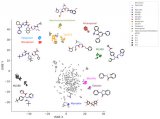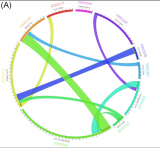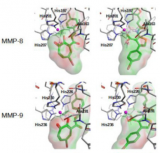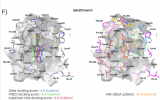Displaying from 1 to 10 of 28 available piece of news
-

A new opinion article about the challenges in distinguishing functional proteins from polyproteins in databases
This opinion article addresses a major issue in molecular biology and drug discovery by highlighting the complications that arise from combining polyproteins and their functional products within the same database entry. This problem, exemplified by the discovery of novel inhibitors for the severe acute respiratory syndrome coronavirus 2 (SARS-CoV-2) main protease, has an influence on our ability to retrieve precise data and hinders the development of targeted therapies. It also emphasizes the need for improved database practices and underscores their significance in advancing scientific research. Furthermore, it emphasizes the need of learning from the SARS-CoV-2 pandemic in order to improve global preparedness for future health crises.
-

A new article about The Mutational Landscape of SARS-CoV-2.
-

A new PhD Thesis
Guillem Macip Sancho defended his PhD thesis entitled “Studying the limits of protein-ligand docking to predict new non-covalent inhibitors for the SARS-CoV-2 main protease” last 15th of May 2023 at the Faculty of Chemistry. Congratulations Guillem.
-

Prediction of Recurrent Mutations in SARS-CoV-2 Using Artificial Neural Networks
We show that it is possible to predict the recurrent mutations (RM) of SARS-CoV-2.
-

Could nucleocapsid be a next-generation COVID-19 vaccine candidate?
Saldivar-Espinoza B, Macip G, Pujadas G, Garcia-Vallve S. Could nucleocapsid be a next-generation COVID-19 vaccine candidate? Int J Infect Dis. 2022 Nov 5;125:231-232. doi: 10.1016/j.ijid.2022.11.002.
-

A Review of the Current Landscape of SARS-CoV-2 Main Protease Inhibitors: Have We Hit the Bullseye Yet?
Macip, G.; Garcia-Segura, P.; Mestres-Truyol, J.; Saldivar-Espinoza, B.; Pujadas, G.; Garcia-Vallvé, S. A Review of the Current Landscape of SARS-CoV-2 Main Protease Inhibitors: Have We Hit the Bullseye Yet? Int. J. Mol. Sci. 2022, 23, 259. https://doi.org/10.3390/ijms23010259
-

Haste makes waste: A critical review of docking-based virtual screening in drug repurposing for SARS-CoV-2 main protease (M-pro) inhibition
Macip G, Garcia-Segura P, Mestres-Truyol J, Saldivar-Espinoza B, Ojeda-Montes MJ, Gimeno A, Cereto-Massagué A, Garcia-Vallvé S, Pujadas G. Haste makes waste: A critical review of docking-based virtual screening in drug repurposing for SARS-CoV-2 main protease (M-pro) inhibition. Med Res Rev. 2021 Oct 26. doi: 10.1002/med.21862. PMID: 34697818.
-

Identification of Broad-Spectrum MMP Inhibitors by Virtual Screening
Gimeno A, Cuffaro D, Nuti E, Ojeda-Montes MJ, Beltrán-Debón R, Mulero M, Rossello A, Pujadas G, Garcia-Vallvé S. Identification of Broad-Spectrum MMP Inhibitors by Virtual Screening. Molecules. 2021 Jul 28;26(15):4553. doi: 10.3390/molecules26154553. PMID: 34361703.
-

Experimental studies confirm the inhibitory capacity of SARS-CoV-2 replication of an antibiotic for veterinary use
A study by the URV's Chemoinformatics and Nutrition Research Group now shows that a new drug, sarafloxacin, also has inhibitory capabilities of M-pro (a key enzyme in the replication and transcription of the virus responsible for COVID-19 ). The European experimental validation initiative, COVID Moonshot, has studied it to check its bioactivity and the results confirm that it is the third drug of the seven identified by this research group that inhibits M-pro. Experimental results with sarafloxacin have also shown that its ability to slow down virus replication is even higher than the two anti-inflammatory drugs that were initially validated.
-

Two anti-inflammatory drugs found that inhibit the Main protease (M-pro) from SARS-CoV-2
A study by the URV's Cheminformatics and Nutrition research group has shown that an anti-inflammatory drug for humans and another for animals inhibit a key enzyme in the replication and transcription of the COVID-19 virus. The results of the work have been validated by the initiative COVIDMoonshot which has carried out in vitro studies and assessed their bioactivity. The results have been published in the "International Journal of Molecular Sciences"
